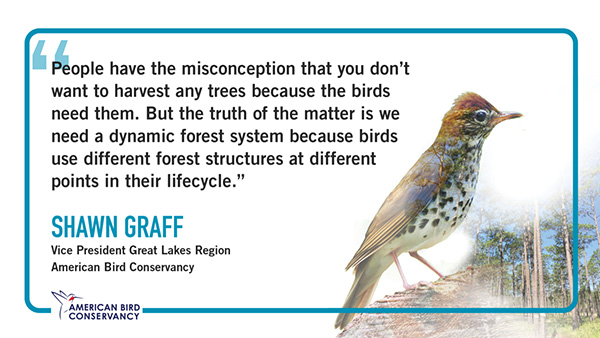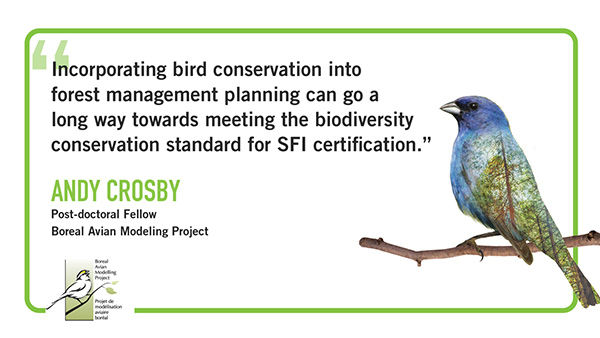A conversation with three bird champions on the importance of cross-border collaboration and bird habitat
Birds don’t recognize borders, which is one reason why an SFI Conservation Grant is supporting a project called “Managed Forests for Birds in the Boreal Transition Region of the U.S. and Canada.” It’s a partnership between SFI, the American Bird Conservancy (ABC), and the Boreal Avian Modeling Project (BAM), an international scientific collaboration based at the University of Alberta. The purpose is to assess and demonstrate the value of SFI-certified forests to important bird populations, and to transfer these learnings across the SFI footprint in North America.
Collaborators on the project will use decision support tools and outreach to engage forest landowners, professional foresters, SFI-certified organizations, and others. By highlighting and enhancing the role of sustainable forest management in the conservation of forest birds, the project will help managers improve habitat and conserve important bird populations in parts of Wisconsin, Minnesota, Michigan, and northwestern Ontario. These learnings will then be applied across the SFI landscape in this region and shared with the conservation community.
Q: What does SFI bring to the project?
A: Darren Sleep, Senior Director, Conservation Science and Strategies, SFI
SFI’s mission is to advance sustainability through forest-focused collaborations, and we’re known for our ability to bring partners together to advance conservation outcomes. ABC, BAM and the various states and certified organizations in the project will benefit from SFI’s convening power and scale. Overall, we have 375 million acres/152 million hectares of forests certified to our standard. Specific to this project, we have 55.8 million acres/22.6 million hectares of certified forestlands across Wisconsin, Minnesota, Michigan and Ontario, the focal area for this work. We hope to take learnings from this project and use them across the continent.
Q: What ABC’s contribution to the project?
A: Shawn Graff, VP Great Lakes Region, ABC
We’ve got a lot of expertise in terms of land management for birds, and we bring the best and latest science to the table. And we’ve got eight foresters on the ground in the project area, working on different habitat types in northern Minnesota, Wisconsin, and Michigan, working to improve habitat on this side of the border. Our broader network of ABC scientists also lend their expertise. And we’re creating two toolkits to help manage forests for birds, one for forest managers and another for private landowners.
Q: How does the project benefit from BAM’s involvement?
A: Andy Crosby, Post-doctoral Fellow, BAM
We have a huge database and strong analytical capacity. We model bird populations and distributions at a very fine resolution over large scales—that’s kind of unique. Coming from the Canadian side, we understand that the land ownership patterns, and management systems and regulatory environments are very different on both sides of the border. But ultimately all these SFI‑certified organizations are trying to meet the same standard. One of the goals I think for us is to help understand how those different pathways can hopefully lead to the same result, which is bird conservation in these forests.

Q: How does sustainable forest management play a role in this project?
A: Shawn Graff, VP Great Lakes Region, ABC
People have the misconception that you don’t want to harvest any trees because the birds need them. But the truth of the matter is we need a dynamic forest system because birds use different forest structures at different points in their lifecycle. And different bird species use different forest structures at different times depending on what they’re doing in the particular season. We need this dynamic forest and what’s great about sustainable forest management practices is that we get this dynamic rotation. So that those birds that need early successional habitat for nesting, which for example is created after harvesting, always have some place to nest. But then they have that adjacent more mature forest where they can fledge later on.

Q: Does this project offer perspective on the conservation values of forestlands certified to SFI?
A: Andy Crosby, Post-doctoral Fellow, BAM
Looking at bird communities, rather than single species, helps us to get at that since these communities can act as a good indicator of general biodiversity across the landscape. The big advantages of looking at birds in relation to sustainable forest management, is that they give you a really good reflection of what’s going on ecologically in that landscape. That means that incorporating bird conservation into forest management planning can go a long way towards meeting the biodiversity conservation standard for SFI certification. Then we can take a fine filter approach to some species that are going to require some specialized forest management that we need to focus on. When we can look across the whole landscape, we can see how well bird populations are doing, and compare them with historical populations. What kind of communities that landscape supported historically gives us a very good way to compare how we’re doing today.
Q: Are you looking at the SFI Fiber Sourcing Standard as part of this project?
A: Darren Sleep, Senior Director, Conservation Science and Strategies, SFI
Yes. The SFI Fiber Sourcing Standard promotes good sustainable forest management over the long-term, even from lands that may not be certified to the SFI Forest Management Standard. Organizations certified to the SFI Fiber Sourcing Standard connect landowners with loggers trained in BMP [best management practices] application and who know how to make the right conservation decisions during forest operations. Studies from the University of Georgia have demonstrated that SFI Fiber Sourcing certification improves the level of sustainable practices that get applied on private forest lands.
A: Andy Crosby, Post-doctoral Fellow, BAM
Yes, SFI fiber sourcing lets us work directly with the landowners to communicate our objectives, improve practices, and start measuring how well we’re meeting those objectives.

Q: How will this project help SFI to translate the conservation value of SFI certified forests to brand owners and consumers seeking to make the right choices about their supply chains?
A: Darren Sleep, Senior Director, Conservation Science and Strategies, SFI
The whole purpose of the project is to help SFI-certified forest owners and SFI-certified sourcing entities promote sustainable forest management for birds. To do that most effectively, we’re asking lots of questions to identify the best approaches. What are the dynamics of Aspen regeneration and how’s that affecting birds? What bird species are of concern? How are they doing? And what stands can be better managed for them? Further down the road, we want to be able to document how sustainable forest management in this footprint helps conserve or recover these species, which will allow us to plan and execute conservation more consistently—that’s the ultimate goal.
